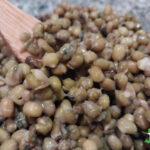
Homemade Soy-free Natto
How to make natto at home easily and inexpensively with mung beans instead of estrogenic soybeans.
Ingredients
- 1 cup dried mung beans unsprouted and organic
- filtered water
- 1 packet natto spores
Instructions
-
Rinse mung beans and place them in a large glass bowl. Cover with enough filtered water to allow the beans to roughly double in size as they expand. Leave on the counter for 8 hours or overnight.
-
Drain the soaking water and place beans in a large pot. Cover with fresh filtered water.
-
Bring the beans to a boil, turn down the temperature to a simmer, affix the lid and cook the beans for about 20 minutes until just soft but not mushy (do not overcook!).
-
Drain the beans and place in a large VitaClay slow cooker or crockpot. The beans should be no more than 1" in depth. Discard any beans that may accidentally spill during the transfer from the pot to a VitaClay (or other slow cooker).
-
Let the beans cool for 10 minutes in the Vitaclay.
-
While the beans are cooling slightly, dissolve a packet of natto starter in 3 Tbsp of warm filtered water.
-
Pour the natto spore solution over the cooled but still warm beans. Stir gently to mix with a clean, bamboo spoon.
-
Place the lid on the VitaClay and select the "yogurt" setting.
If using a different type of slow cooker, use the setting that will keep the beans between 100-110 °F/ 38-43 °C which is the temperature range necessary to ferment the beans into natto.
-
After 24 hours, turn off the Vitaclay, remove the lid, and cool the natto to room temperature for 1 hour. A whitish film and an ammonia-like aroma means they are done. The beans will also have a stringy and slimy appearance (see photo above).
-
Place the cooled natto in a glass container with a tight-fitting lid and refrigerate.
-
Natto will be ready to eat once refrigerated overnight. It will last for months, and the flavor will age and strengthen with time.
-
Mung beans contain less than 1% of the isoflavones in soy. Thus, feel free to eat 1-3 tablespoons per day of mung bean natto for an inexpensive and tasty soil-based probiotic and Vitamin K2 food source.